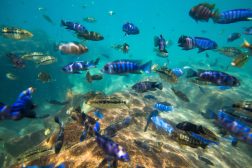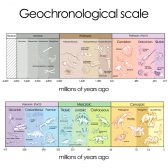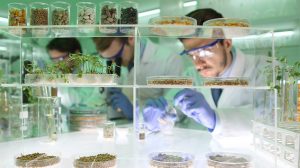Lotic Communities & Animals

Salmon jumping upstream in the river
A running water environment offers numerous microhabitats that simulate favorable conditions for many types of animals to successfully succeed in the freshwater lotic community. As with plants, animals in this ecosystem have also underwent ongoing evolutionary adaptations to better suit this running water environment.
As with plants and their rooting structure, animals have also adapted to cope with the current of the stream.
Some of these animals are sessile, meaning they are immobile and fixed to one place. These animals are usually small and include the protozoans and some freshwater sponges. These animals either remain attached to the mass of a plant or the water bank surface or rock. They usually obtain their food via tentacles that branch out into the flowing water and form a catchment area that can trap microscopic organisms (such as plankton) that is floating downstream.
As much as these sessile animals have developed adaptations to prevent being washed downstream, they are not thought to be one of the important pillars of the freshwater community. Over time when biotic and abiotic factors affect the landscape of the ecosystem over time, the location of these animals may not be as favorable as it once was, and they are unable to correct this due to their immobile nature. With this in light, some animals have developed adaptations that allow them to travel through the water without being inhibited in the same spot.
Animals have developed some of the following adaptations over time that helps them cope with the conditions in hand:
- Suckers – These suckers attach themselves to a surface that leeches them into position and can also assist movement in any given direction.
- Hooks / Claws – These sharp objects can dig into any given object and allow the animal to cling to a position or claw their way around the surface.
- Body flattening – This adaptation can allow the animal in the water to bear less of the brunt of the force of water moving downstream, therefore reducing it as an inhibitor of their movement. This also allows these animals to enter confined areas (such as under stones) that may present a useful environment for them to live in.
- Streamlining – Just like man-made transport, animals who have undergone streamlining adaptations on their external appearance means that less resistance is presented by the running water when the animal attempts to move.
- Flight – Some animals have adaptations allowing them to fly, removing themselves from the force of the current at ground level and enabling them to move upstream more easily if needs be.
You will also like...

Still Water Animals
Animals living in aquatic habitats have diversified and evolved through time. They eventually occupy ecological niches a..

Developmental Biology
Developmental biology is a biological science that is primarily concerned with how a living thing grows and attains matu..

Geological Periods
Geological periods is a study guide that cites the different geological periods on Earth's timeline. Each has a brief ov..

Fruits, Flowers, and Seeds
This tutorial deals with the structure and function of flowers, fruits, and seeds. Also included here are the types of f..

Regulation of Biological Systems
Regulation of Biological Systems tutorials are focused on the modulation of biological systems from cell to population l..

Meiosis and Alternation of Generations
Plants are characterized by having alternation of generations in their life cycles. This tutorial is a review of plant m..
